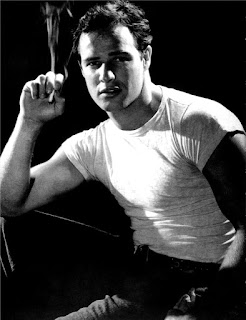If you ever
wonder who you are, check your t-shirts.
A T-shirt (or
tee shirt, or tee) is a style of unisex fabric shirt, named after the T shape
of the body and sleeves. It is normally associated with short sleeves, a round
neckline known as a crew neck, with no collar. T-shirts are generally made of a
light, inexpensive fabric, and are easy to clean.
Typically made
of cotton textile in a jersey knit, it has a distinctively pliable texture
compared to shirts made of woven cloth. The majority of modern versions have a
body made from a continuously woven tube, on a circular loom, so that the torso
has no side seams. The manufacture of T-shirts has become highly automated, and
may include fabric cutting by laser or water jet.
A V-neck
T-shirt has a V-shaped neckline, as opposed to the round neckline of the more
common crew neck shirt (also called a U-neck). V-necks were introduced so that
the neckline of the shirt does not stand out when an outer shirt is worn over
it, thus reducing or eliminating the visible cloth above the outer shirt of a
crew neck shirt.
The T-shirt
evolved from undergarments used in the 19th century and were adopted by miners
and stevedores due to hot working conditions, and in the mid-20th century
transitioned from undergarment to general-use casual clothing.
As slip-on
garments without buttons, the earliest T-shirt dates back to sometime between
the 1898 Spanish–American War and 1913, when the U.S. Navy began issuing them
as undergarments. These were a crew-necked, short-sleeved, white cotton
undershirt to be worn under a uniform. It became common for sailors and Marines
in work parties, the early submarines, and tropical climates to remove their
uniform jacket, wearing (and soiling) only the undershirt.
They soon
became popular as a bottom layer of clothing for workers in various industries,
including agriculture. The T-shirt was easily fitted, easily cleaned, and
inexpensive, and for those reasons it became the shirt of choice for young
boys. Boys' shirts were made in various colors and patterns.
By the Great
Depression, the T-shirt was often the default garment to be worn when doing
farm or ranch chores, as well as other times when modesty called for a torso
covering but conditions called for lightweight fabrics. Following World War II,
it became common to see veterans wearing their uniform trousers with their
T-shirts as casual clothing. The shirts became even more popular in the 1950s
after Marlon Brando wore one in A Streetcar Named Desire, finally achieving status
as fashionable, stand-alone, outerwear garments. Often boys wore them while
doing chores and playing outside, eventually opening up the idea of wearing
them as general-purpose casual clothing.
Printed
T-shirts were in limited use by 1942 when an Air Corps Gunnery School T-shirt
appeared on the cover of Life magazine. In the 1960s, printed T-shirts gained
popularity for self-expression as well for advertisements, protests, and
souvenirs.
Current
versions are available in many different designs and fabrics, and styles
include crew-neck and V-neck shirts.
The first time
I saw tee-shirts was at the beach in the local drinking establishment where
World War II veterans would sit on wooden stools in their sailor hats and white
t-shirts smoking cigarettes, drinking a assortment of vile potions and showing
off their fading wrinkled tattoos.
No one I knew
wore t-shirts. No one wore t-shirts under their dress shirts and instead had to
put on jackets to cover their sweaty armpits. A t-shirt was the sign of the lower
blue-collar class, but the fad was catching on. Like pajama tops, t-shirts were
becoming popular in the middle-class for the boys were ripping their oxford
shirts and they were cheap and easy to clean. There were horizontal stripes but
no patterns or colors.
By college the
artsy types were starting to draw on t-shirts. Thought they were hard to lay
flat they could be illustrated with markers while being worn, though the person
wearing it usually had to wash off the tattoo that bled through the material.
Kids started silk-screening messages and symbols but the paints would quickly
fade after washing. Then there was tie-dye.
Putting aside
the collared shirts and ties (a collar is a device of any material worn by a
person around the neck to indicate their submissive or slave status) and pulling
on the easy to wear and replace t-shirt became a counterculture uniform. Madison
Avenue caught the trend of the Boomers and started making the t-shirt more
fashionable. T-shirts showed the logo of your favorite band or rock concert or
shoe as the marketing exploded until everyone was a walking billboard. Even the
tank top t-shirt that give more room for the arms to breath shrunk for the
muscle bound and oversized for the basketball court.
Go to any
retirement village and notice what the elderly wear. It is so much trouble to
put on fancy clothing so easy-to-wear is the norm. Don’t be concerned if
patterns and colors don’t match, wear what is comfortable.
Maybe that is
the way fashion should be?



No comments:
Post a Comment